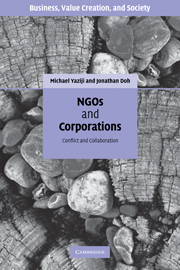Book contents
- Frontmatter
- Contents
- List of figures
- List of tables
- Preface
- Foreword
- Acknowledgments
- Part I Understanding NGOs
- Part II NGO advocacy campaigns
- 4 NGO campaigns against corporations and (de-)legitimacy
- 5 How do they do it? Understanding the power and influence of radical advocacy NGOs
- 6 NGO campaign types and company responses
- Case illustration: PETA and KFC
- Case illustration: Coca-Cola in India
- Part III Corporate–NGO engagement
- Part IV The future of corporate–NGO relations
- Index
- References
4 - NGO campaigns against corporations and (de-)legitimacy
Published online by Cambridge University Press: 13 January 2010
- Frontmatter
- Contents
- List of figures
- List of tables
- Preface
- Foreword
- Acknowledgments
- Part I Understanding NGOs
- Part II NGO advocacy campaigns
- 4 NGO campaigns against corporations and (de-)legitimacy
- 5 How do they do it? Understanding the power and influence of radical advocacy NGOs
- 6 NGO campaign types and company responses
- Case illustration: PETA and KFC
- Case illustration: Coca-Cola in India
- Part III Corporate–NGO engagement
- Part IV The future of corporate–NGO relations
- Index
- References
Summary
NGO campaigns can severely threaten profitable firms and constrain their scope for strategic action. For example, under pressure by a coalition of advocacy NGOs, Aventis paid more than $500 million to buy back genetically modified StarLink corn from growers, fired the head of its US crop sciences division and spun off its agricultural business (see Case illustration on p. 46). In another case, the Free Burma Coalition of NGOs forced companies such as Levi Strauss, Macy's, Liz Claiborne, PepsiCo, Texaco, Amaco, ABN AMRO, Kodak, Apple, Disney, Motorola and many others out of Burma. Pharmaceutical companies have also been targeted as AIDS activist NGOs pressured them with threats of negative public relations regarding patents on AIDS drugs in South Africa. Companies targeted in that campaign included GlaxoSmithKline, Merck & Co., Bristol-Myers Squibb, Roche and others.
Peter Drucker stated that, “in the next society, the biggest challenge for the large company – especially for the multinational – may be its social legitimacy.” Raymond Vernon noted that these advocacy organizations were increasingly pushing firms, under threat of delegitimation and its attendant costs, in order to support the norms and values that the NGOs were dedicated to promote. In this chapter we will start by highlighting how these campaigns represent an under-studied area of risk for firms. We will then turn to looking at the process and risk factors of these campaigns.
- Type
- Chapter
- Information
- NGOs and CorporationsConflict and Collaboration, pp. 57 - 73Publisher: Cambridge University PressPrint publication year: 2009



